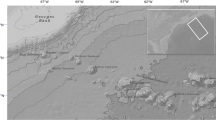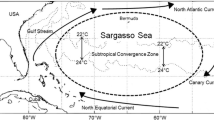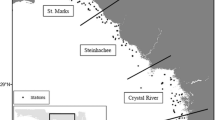Abstract
Bear Seamount (BSM) is the most inshore seamount in the New England Seamount chain. It is located within the U.S. Exclusive Economic Zone and is contained within the recently established Northeast Canyons and Seamounts Marine National Monument. In 2000, the National Oceanic and Atmospheric Administration’s (NOAA) National Systematics Laboratory began an exploratory trawling program to document nekton diversity at BSM and its vicinity. Here, we summarize eight exploratory sampling cruises conducted between 2000 and 2014, and describe the cephalopod biodiversity and assemblage structure around BSM. Over the course of 174 deep–midwater and 56 bottom tows, 5088 cephalopods were identified, measured, and documented. In total, 77 species were collected at BSM; 75 species were collected from midwater tows and 28 from benthic tows. Rarefaction curves did not reach an asymptote, suggesting that additional sampling will collect more species. Seventeen species accounted for 75% of the total midwater and bottom catch, including: Illex illecebrosus (n = 605), Magnoteuthis magna (n = 568), Abraliopsis morisii (n = 518), Abralia redfieldi (n = 358), Mastigoteuthis agassizii (n = 336), Histioteuthis reversa (n = 273), Taonius pavo (n = 239), Haliphron atlanticus (n = 195), Brachioteuthis beanii (n = 160), Ornithoteuthis antillarum (n = 153), Pterygioteuthis gemmata (n = 141), Pyroteuthis margaritifera (n = 120), Vampyroteuthis infernalis (n = 101), Chiroteuthis veranyi (n = 33), Bolitaena pygmaea (n = 30), Graneledone verrucosa (n = 11), and Stauroteuthis syrtensis (n = 29). Non-metric multidimensional scaling (NMDS) of significant analysis of similarity (ANOSIM) results showed that the 2000 cruise was different from other years, meteorological winter was different from other seasons, and that day and night shallow samples were different from each other and all other depths. Based on seasonal size variation in the most abundant taxa, we propose hypotheses of year-round, winter, and spring spawning for future critical assessment. This extensive description of the offshore cephalopod assemblage may be used to assess vulnerability to future environmental changes and human activities.









Similar content being viewed by others
References
Arkhipkin AI (1996a) Age and growth of planktonic squids Cranchia scabra and Liocranchia reinhardti (Cephalopoda, Cranchiidae) in epipelagic waters of the central-east Atlantic. J Plankton Res 18:1675–1683
Arkhipkin AI (1996b) Statolith microstructure and age of early life stages of planktonic squids Galiteuthis phyllura and Belonella borealis (Oegopsida, Cranchiidae) from the northern North Pacific. J Plankton Res 18:123–132
Clark MR, Rowden AA, Schlacher T, Williams A, Consalvey M, Stocks KI, Rogers AD, O’Hara TD, White M, Shank TM, Hall-Spencer JM (2010) The ecology of seamounts: structure, function, and human impacts. Annu Rev Mar Sci 2:253–278
Clark MR, Schlacher TA, Rowden AA, Stocks KI, Consalvey M (2012) Science priorities for seamounts: research links to conservation and management. PLoS ONE 7(1), e29232. doi:10.1371/journal.pone.0029232
Clarke MR (1977) Beaks, nets and numbers. Symp Zool Soc Lond 38:89–126
Clarke KR (1993) Non-parametric multivariate analyses of changes in community structure. Aust J Ecol 18:117–143
Clarke MR (1996) Cephalopods as prey. III. Cetaceans. Philos Trans R Soc B 351(1343):1053–1065
Clarke KR, Gorley RN (2006) PRIMER v6: user manual/tutorial. PRIMER-E, Plymouth, England
Clarke MR, Lu CC (1975) Vertical distribution of cephalopods at 18°N 25°W in the North Atlantic. J Mar Biol Assoc UK 55(1):165–182
Clarke MR, Pascoe PL (1997) Cephalopod species in the diet of a sperm whale (Physeter catodon) stranded at Penzance, Cornwall. J Mar Biol Assoc UK 77(4):1255–1258
Clarke KR, Warwick RM (2001) Change in marine communities: an approach to statistical analysis and interpretation, 2nd edn. PRIMER-E, Plymouth, England
Collins MA, Henriques C (2000) A revision of the family Stauroteuthidae (Octopoda: Cirrata) with redescriptions of Stauroteuthis syrtensis and S. gilchristi. J Mar Biol Assoc UK 80:685–697
Colwell RK (2013) EstimateS 9.1.0 user’s guide. Available online at: http://viceroy.eeb.uconn.edu/estimates/
Dawe EG, Stephen SJ (1988) The cephalopod assemblage of the Gulf Stream System East of 60°W. Malacologia 29(1):235–245
De Forest L, Drazen J (2009) The influence of a Hawaiian Seamount on mesopelagic micronekton. Deep Sea Res 56:232–250
Diekmann R, Piatkowski U, Schneider M (2002) Early life and juvenile cephalopods around seamounts of the subtropical North Atlantic: Illustrations and a key for their identification. Berichte aus dem Institut für Meereskunde der Christian-Albrechts-Universität Kiel 326:1–42
Drazen JC, Goffredi SK, Schlining B, Stakes DS (2003) Aggregations of egg-brooding deep-sea fish and cephalopods on the Gorda Escarpment: a reproductive hot spot. Biol Bull 205:1–7
Epp D, Smoot NC (1989) Distribution of seamounts in the North Atlantic. Nature 337:254–257
Gannon DP, Ready AJ, Craddock JE, Mead JG (1997) Stomach contents of long-finned pilot whales (Globicephala melas) stranded on the U.S. mid-Atlantic coast. Mar Mamm Sci 13:405–418
Gotelli NJ, Colwell RK (2001) Quantifying biodiversity: procedures and pitfalls in the measurement and comparison of species richness. Ecol Lett 4:379–391
Hamilton P, McDowell S, Waddell E, Redford D, Pabst D (1996) Slope sea currents during the 1990–1991 106-mile site investigations. J Mar Environ Eng 2:203–225
Hoving HJT, Perez JAA, Bolstad KSR, Braid HE, Evans AB, Fuchs D, Judkins H, Kelly JT, Marian JEAR, Nakajima R, Piatkowski U, Reid A, Vecchione M, Xavier JCC (2014) The study of deep-sea cephalopods. Adv Mar Biol 67:235–359
Hoving HJT, Laptikhovsky VV, Robison BH (2015) Vampire squid reproductive strategy is unique among coleoid cephalopods. Curr Biol 25:R322–R323
Howell KL, Mowles SL, Foggo A (2010) Mounting evidence: near-slope seamounts are faunally indistinct from an adjacent bank. Mar Ecol 31(suppl 1):52–62
Jereb P, Roper CFE (eds) (2010) Cephalopods of the world. An annotated and illustrated catalogue of cephalopod species known to date, vol. 2. Myopsid and Oegopsid Squids. FAO Species Catalogue for Fishery Purposes. No. 4, Vol. 2. FAO, Rome, 605 p
Judkins H, Ingrao DA, Roper CFE (2009) First records of Asperoteuthis acanthoderma (Lu, 1977) (Cephalopoda: Oegopsida: Chiroteuthidae), from the North Atlantic Ocean, Straits of Florida. Proc Biol Soc Wash 122(2):162–170
Kenchington TJ, Best M, Bourbonnais-Boyce C, Clement P, Cogswell A, MacDonald B, MacEachern WJ, MacIsaac K, MacNab P, Paon L, Reid J, Roach S, Shea L, Themelis D, Kenchington ELR (2009) Methodology of the 2007 survey of meso- and bathypelagic micronekton of the Sable Gully: Cruise TEM768. Can Tech Rep Fish Aquat Sci 2853:vi-91
Kristensen TK (1984) Biology of the squid Gonatus fabricii (Lichtenstein, 1818) from West Greenland waters. Meddr Greenland Biosci 13:1–17
Logan JM, Toppin R, Smith S, Galuardi B, Porter J, Lutcavage M (2013) Contribution of cephalopod prey to the diet of large pelagic fish predators in the central North Atlantic Ocean. Deep Sea Res Part II 95:74–82
Lu CC, Roper CFE (1979) Cephalopods from deepwater dumpsite 106 (Western Atlantic): vertical distribution and seasonal abundance. Smithson Contrib Zool 288:1–36
McClain CR (2007) Seamounts: identity crisis or split personality? J Biogeogr 34:2001–2008
Mills KE, Pershing AJ, Brown CJ, Chen Y, Chiang F-S, Holland DS, Lehuta S, Nye JA, Sun JC, Thomas AC, Wahle RA (2013) Fisheries management in a changing climate: lessons from the 2012 ocean heat wave in the Northwest Atlantic. Oceanography 26(2)191–195. doi:10.5670/oceanog.2013.27
Mintzer VJ, Gannon DP, Barros NB, Read AJ (2008) Stomach contents of mass-stranded short-finned pilot whales (Globicephala macrorhynchus) from North Carolina. Mar Mamm Sci 24(2):290–302
Moore JA, Vecchione M, Collette BB, Gibbons R, Hartel KE, Galbraith JK, Turnipseed M, Southworth M, Watkins E (2003a) Biodiversity of Bear Seamount, New England seamount chain: results of exploratory trawling. J Northwest Atl Fish Sci 31:363–372
Moore JA, Hartel KE, Craddock JE, Galbraith JK (2003b) An annotated checklist of deepwater fishes from off New England, with 110 range extensions and 81 new records off New England. Northeast Nat 10(2):159–248
Moore JA, Vecchione M, Collette BB, Gibbons R, Hartel KE (2004) Selected fauna of Bear Seamount (New England Seamount chain), and the presence of “natural invader” species. Arch Fish Mar Res 51(1–3):241–250
National Oceanic Atmospheric Administration (NOAA) (2016) FACT SHEET: President Obama to Continue Global Leadership in Combatting Climate Change and Protecting Our Ocean by Creating the First Marine National Monument in the Atlantic Ocean. Available online at: https://www.whitehouse.gov/the-press-office/2016/09/15/fact-sheet-president-obama-continue-global-leadership-combatting-climate. Accessed 14 Dec 2016
Nesis KN (1987) Cephalopods of the world. Squids, cuttlefishes, octopuses and allies. TFH Publications, Neptune City
Nesis KN (1994) Teuthofauna of Walters Shoals, a seamount in the southwestern Indian Ocean. Ruthenica 4:67–77
Nesis KN (1995) Mating, spawning and death in oceanic cephalopods: a review. Ruthenica Suppl 6:23–64
O’Dor RK, Dawe EG (2013) Illex illecebrosus, Northern Short-finned squid. In: Rosa R, Pierce G, O’Dor R (eds) Advances in squid biology, ecology and fisheries. Part II, Oegopsid squids. Nova Science Publishers, New York, pp 73–108
O’Hara TD (2007) Seamounts: centres of endemism or species richness for ophiuroids? Glob Ecol Biogeogr 16:720–732
O’Shea S (2004) The giant octopus Haliphron atlanticus (Mollusca: Octopoda) in New Zealand waters. N Z J Zool 31:7–13
Pickford GE (1946) Vampyroteuthis infernalis Chun: an archaic dibranchiate cephalopod: I. Natural history and distribution. Dana Rep 29:1–40
Pickford GE (1949) The distribution of the eggs of Vampyroteuthis infernalis Chun. J Mar Res 8(1):73–83
Pitcher TJ, Morato T, Hart PJB, Clark MR, Haggan N, Santos RS (eds) (2008) Seamounts: ecology, fisheries & conservation. Blackwell, Oxford
Ramirez-Llodra E, Brandt A, Danovaro R, De Mol B, Escobar E, German CR, Levin LA, Martinez Arbizu P, Menot L, Buhl-Mortensen P, Narayanaswamy BE, Smith CR, Tittensor DP, Tyler PA, Vanreusel A, Vecchione M (2010) Deep, diverse and definitely different: unique attributes of the world’s largest ecosystem. Biogeosciences 7:2851–2899
Richer de Forges B, Koslow JA, Poore GCB (2000) Diversity and endemism of the benthic seamount fauna in the southwest Pacific. Nature 405:944–947
Rogers AD (1994) The biology of seamounts. Adv Mar Biol 30:305–350
Roper CFE (1977) Comparative captures of pelagic cephalopods by midwater trawls. Symp Zool Soc Lond 38:61–87
Roper CFE (1992) Family Neoteuthidae. In: Sweeney MJ et al (eds) “Larval” and juvenile cephalopods: a manual for their identification. Smithson Contrib Zool 513:101–104
Roper CFE, Vecchione M (1996) In situ observations on Brachioteuthis beanii (Verrill): paired behavior, possibly mating (Cephalopoda, Oegopsida). Am Malacol Bull 13(12):55–60
Roper CFE, Young RE (1975) Vertical distribution of pelagic cephalopods. Smithson Contrib Zool 209:1–51
Roper CFE, Nigmatullin C, Jereb P (2010) Family Ommastrephidae. In: Jereb P, Roper CFE (2010) Cephalopods of the world. An annotated and illustrated catalogue of cephalopod species known to date. Volume 2.Myopsid and Oegopsid Squids. FAO Species Catalogue for Fishery Purposes. FAO, Rome
Samadi S, Bottan L, Macpherson E, Richer De Forges B, Boisselier M-C (2006) Seamount endemism questioned by the geographic distribution and population genetic structure of marine invertebrates. Mar Biol 149:1463–1475
Shea EK, Vecchione M (2010) Ontogenic changes in diel vertical migration patterns compared with known allometric changes in three mesopelagic squid species suggest an expanded definition of a paralarva. ICES J Mar Sci 67:1436–1443
Smith DK, Jordan TH (1988) Seamount statistics in the Pacific Ocean. J Geophys Res 93(B4):2899–2918
Staudinger MD, Juanes F, Salmon B, Teffer AK (2013) The distribution, diversity, and importance of cephalopods in top predator diets from offshore habitats of the Northwest Atlantic Ocean. Deep Sea Res Part II 95:182–192
Staudinger MD, McAlarney RJ, McLellan W, Pabst DA (2014) Foraging ecology and niche overlap in pygmy (Kogia breviceps) and dwarf (Kogia sima) sperm whales from waters of the U.S. mid-Atlantic coast. Mar Mamm Sci 30(2):626–655
Teffer AK, Staudinger MD, Juanes F (2015) Trophic niche overlap among dolphinfish and co-occurring tunas near the northern edge of their range in the western North Atlantic. Mar Biol 162(9):1823–1840
Uchupi E, Phillips JD, Prada KE (1970) Origin and structure of the New England seamount chain. Deep Sea Res Ocean Abst 17(3):483–494
Vecchione M (2001) Cephalopods of the continental slope east of the United States. Am Fish Soc Symp 25:153–160
Vecchione M, Galbraith J (2001) Cephalopod species collected by deepwater exploratory fishing off New England. Fish Res 51(2):385–391
Vecchione M, Pohle G (2002) Midwater cephalopods in the western North Atlantic Ocean off Nova Scotia. Bull Mar Sci 71(2):883–892
Vecchione M, Roper CFER, Sweeney MJ, Lu CC (2001) Distribution, relative abundance and developmental morphology of paralarval cephalopods in the Western North Atlantic Ocean. NOAA Technical Report NMFS 152, pp 1–54
Vecchione M, Bergstad OA, Byrkjedal I, Falkenhaug T, Gebruk AV, Godø OR et al (2010) Biodiversity patterns and processes on the Mid-Atlantic Ridge. In: McIntyre AD (ed) Life in the world’s oceans: diversity, distribution, and abundance. Wiley-Blackwell, Oxford, pp 103–121
Vecchione M, Sosnowski A, Young RE (2015) Walvisteuthis jeremiahi n. sp. (Mollusca: Cephalopoda), an onychoteuthid squid from the Gulf of Mexico. Proc Biol Soc Wash 128(2):164–175
Vinnichenko VI (1997) Russian investigations and deep water fishery on the Corner Rising Seamount in Subarea 6. NAFO Sci Coun Studies 30:41–49
Voss NA, Stephen SJ, Dong Z (1992) Family Cranchiidae Prosch, 1849. In: Sweeney MJ et al (eds) “Larval” and juvenile cephalopods: A manual for their identification. Smithson Contrib Zool 513:187–210
Voss NA, Nesis KN, Rodhouse PG (1998) The cephalopod family Histioteuthidae (Oegopsida): systematics, biology, and biogeography. Smithson Contrib Zool 586:293–372
Webb TJ, Vanden Berghe E, O’Dor R (2010) Biodiversity’s big wet secret: the global distribution of marine biological records reveals chronic under-exploration of the deep pelagic ocean. PLoS One 5(8), e10223. doi:10.1371/journal.pone.0010223
Wessel P, Sandwell DT, Kim S-S (2010) The global seamount census. Oceanography 23:24–33
Wilson RR, Kaufmann RS (1987) Seamount biota and biogeography. In: Keating BH, Fryer P, Batiza R, Boehlert GW (eds) Seamounts, islands, and atolls. Geoph Monog Ser 43:319–334
Young RE (1995) Aspects of the natural history of pelagic cephalopods of the Hawaiian mesopelagic-boundary region. Pac Sci 49(2):143–155
Young RE, Roper CFE (1969) A monograph of the Cephalopoda of the North Atlantic: the family Cycloteuthidae. Smithson Contrib Zool 5:1–24
Young RE, Vecchione M (2005) Narrowteuthis nesisi, a new genus and new species of the squid family Neoteuthidae (Mollusca: Cephalopoda). Proc Biol Soc Wash 118(3):566–569
Young RE, Harman RF, Mangold KM (1985a) The common occurrence of oegopsid squid eggs in near-surface oceanic waters. Pac Sci 39(4):359–366
Young RE, Harman RF, Mangold KM (1985b) The eggs and larvae of Brachioteuthis sp. (Cephalopoda: Teuthoidea) from Hawaiian waters. Vie Milieu 35:203–209
Acknowledgments
We thank the Captain and crew of the NOAA Ship Delaware II and NOAA Ship Pisces, and all of the participants in these cruises for their efforts in collecting specimens, samples, and data. Jon Moore provided the multibeam map in Fig. 1 which was created by the Mountains in the Sea Research Group. Heather Godra produced the sea surface temperature map in Fig. 9, while supported by a 2010 Census of Seamounts MiniGrant program (Census of Marine Life, funded by the Sloan Foundation). Invertebrate Zoology collections management staff curated the specimens and digitized collections data. We thank Dr. Chingis Nigmatullin and the two anonymous reviewers for their careful review of the manuscript. V. H. Dimkovikj was supported as part of an undergraduate research opportunity with Coastal Carolina University, NSF REU Site EAR-1062692, as well as through a Natural History Research Experiences summer internship at the Smithsonian Institution.
Author information
Authors and Affiliations
Corresponding author
Additional information
Communicated by Y. Sakurai
Rights and permissions
About this article
Cite this article
Shea, E.K., Judkins, H., Staudinger, M.D. et al. Cephalopod biodiversity in the vicinity of Bear Seamount, western North Atlantic based on exploratory trawling from 2000 to 2014. Mar Biodiv 47, 699–722 (2017). https://doi.org/10.1007/s12526-017-0633-3
Received:
Revised:
Accepted:
Published:
Issue Date:
DOI: https://doi.org/10.1007/s12526-017-0633-3




